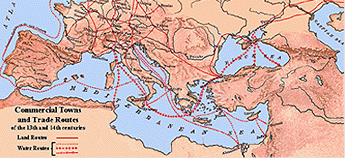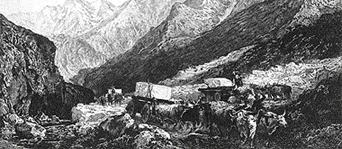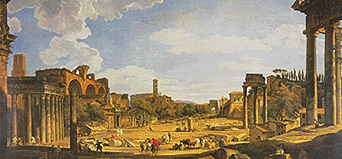Conditions Influencing Architecture
The Italian Climate
Because Italy is over 700 miles long and the northern part is at a higher altitude, the climate varies greatly from north to south. The variation is greatest in the winter, when snow makes the Italian Alps ideal for skiing. In other seasons, Italy is pleasant to very hot.
Features Suited to a Warm Climate
Italy's warm climate favors open-air spaces and features that minimize the heat.
●Loggias. A loggia is a structure that is covered by a roof or another story and is open on one or more sides. In the Renaissance, loggias (loggie in Italian) were generally constructed as a series of vaults whose arcaded sides were carried on columns or piers. Loggias, which were ubiquitous in Renaissance Italy, commonly stood outside public buildings and lined the facings of courtyards. They were frequently used at villas, especially on their garden facings, and incorporated into gardens as pavilions.
●Courtyards. A courtyard (cortile in Italian) is a space that is enclosed by a building or buildings and is open to the sky. Courtyards serve as light wells and provide open-air space. Loggias were commonly used on the ground story and some upper stories. Because of their utility, courtyards were at the centers of many types of Italian buildings in the Renaissance, particularly palaces, both public and private. When used at monasteries, they are called cloisters.
●Shallow-pitched roofs. Because shedding snow was less important than repelling heat in most of Italy, roofs were given shallow pitches, which reduced the area of sun-absorbing surface. Clay tile roofing was commonly used.
●Attic stories. Attic stories were used to provide an insulating layer between the roof and the quarters below.
Villas for Escaping Summer Heat
The desire to escape the city heat in the summer was one of the reasons that wealthy families built villas in the countryside.
The rolling country of the foothills of the mountains is ideal for villas because of the cool temperatures and scenic conditions. To accommodate the sloping terrain, villas were often laid out as a series of terraces.
Shape Facilitating Stylistic Independence
As a long and relatively narrow peninsula, Italy is in contact with continental Europe only in the north, where the Alps form a natural barrier. In being relatively isolated from Europe, Italy was free to develop on its own stylistically.
Conditions Affecting Prosperity
Several regional conditions affected local prosperity, which in turn, affected the amount of money available for architectural construction.
●Proximity to trade routes and rivers. Many cities benefited from their location near ports or on major trade routes or rivers. Venice's position on the Adriatic Sea made the city the hub of the main trade routes from Europe to the East. Milan, Bologna, and Florence benefited from being on an international trade route from Paris to Rome, which ran through the center of Italy. Milan also benefited from being located on navigable lakes and rivers. Rivers benefited many other northern cities like Mantua, Ferrara, and Verona, which were located on the Mincio, Po, and Adige Rivers, respectively. In central Italy, both Florence and Pisa were located on the Arno, and Rome enjoyed not only the Tiber River but also proximity to the port of Ostia.
●Suitability of land for farming and herding. Land varied regionally in its suitability for growing food and pasturing animals. In Tuscany, where exporting textiles was an important business, sheep herding was vital for providing wool.
●Availability of building materials. Natural resources that could be used in construction such as stone and timber were valuable for both local use and export. Prato and Carrara were known for their fine marble, which they exported. The character of the available materials was a factor in a region's architectural design. The abundance of colored marble in Tuscany was reflected by the use of encrusted marble on medieval and Renaissance churches.
Extreme Conditions Posed by Terrain
In some regions, the extremes of the terrain required modifying the land or designing structures that accommodated it.
●Lagoon adjacent to Venice. Venice's location on silt-based land beside a lagoon (a shallow body of water isolated from the sea by dunes or reefs) made canals more practical than streets. The unusual conditions of the site led to Venetian palaces having a number of site-related features.
●Swamplands within Venetian Mainland. Much of the area in close proximity to the Adriatic was dotted with swamps that had to be drained to make them suitable for farming. Farms were desirable not only because they provided food and wine for local use and export but also because land that was occupied could be defended against invasion more readily than land that was not. Because the Venetian Republic lost several sources of wealth, alternative sources of income like farming were sought in the sixteenth century. Consequently, the Venetian government encouraged wealthy Venetians to built farms on the mainland, and many farm villas were constructed at this time. Villas in the flat countryside of the Venetian mainland were generally spread out laterally. Some were one-story high throughout and others had a two-story central section, which was characteristic of the many villas in this region that were designed by Andrea Palladio. To accommodate the needs of a working farm without compromising a villa's beauty, Palladio often designed farm buildings in the form of symmetrical wings.
● Steep Mountains Traversing Italy. The presence of the Apennines, a chain of mountains that traverses Italy from northwest to southeast and includes eight ranges, contributed to Italy's regionalism by serving as a natural barrier.
POLITICAL AND HISTORICAL CONDITIONS
Frequent Warfare in Italy
Italy was the site of much warfare in the Renaissance. Italy's many separate political entities were frequently at war with one another over territory and political dominance. Often, larger and more powerful states like Florence fought to annex neighbors like Siena and Pisa.
A second source of warfare came from foreign invasion by France and Spain, with the latter increasingly dominating Italy.
Warfare's Impeding Architectural Pursuits
In regions where there was an on-going threat from hostile neighbors, the expense of soldiers and equipment for military defense absorbed funds and bronze that might have been devoted to architecture and sculpture. For instance, Leonardo da Vinci's clay model for an over-life-size equestrian statue honoring Ludovico Sforza's father was never used to cast the finished work because Ludovico needed all available bronze for cannon, and the model itself was used for target practice. After the French conquest of Milan, lavish Sforza commissions ceased.
The 1527 sack of Rome affected construction throughout the city. At the Vatican, work was halted for a few years, and at the Villa Madama, work was abandoned altogether, leaving the villa less than half completed.
Gunpowder's Affect on Fortifications
The introduction of gunpowder into European warfare affected military architecture during the Renaissance. From ancient and medieval times, most cities had high walls, which proved to be inadequate against cannon fire. Consequently, the Renaissance was a time of transition from barriers that were high and thin to those that were low and thick. The new system is called trace Italienne. Threatened cities like Siena were forced to build comprehensive systems of defense.
Government Form and Patronage
The form of government in a community had a big effect on the patronage of architecture.
Influences from Indigenous Past Traditions
Because the models of past architecture, especially ancient Roman architecture, were widely studied by Renaissance architects, the number and styles of buildings and ruins from the past in a particular region affected the local architecture.
For instance, in Florence, the first classical loggia on a public building consisted of Corinthian columns carrying round arches. Although these components are typical of ancient Roman architecture, their proportions and the way they are assembled is not. The columns differ in being more slender, widely spaced, and used in conjunction with an arcade, features that have counterparts at several Tuscan-Romanesque buildings in Florence, including a baptistery that was then believed to be ancient.
The ancient Romans, on the other hand, supported arches using piers instead of columns, and when columns were also used, they functioned as ornamentation. Because many examples of this form could be seen in Rome, it is not surprising that the first Renaissance usages of this ensemble also occurred in Rome.
|
The prosperity resulting from their location on a major trade route fostered much building activity in the cities of Milan, Venice, Florence, and Rome.
|
|
The availability of stone in many parts of central Italy was reflected by its use on much of the architecture of that region.
|
|
The presence of ancient Roman ruins affected Renaissance architecture by providing models for composition and detail. |



 Add Placemark
Add Placemark Go Back
Go Back 







